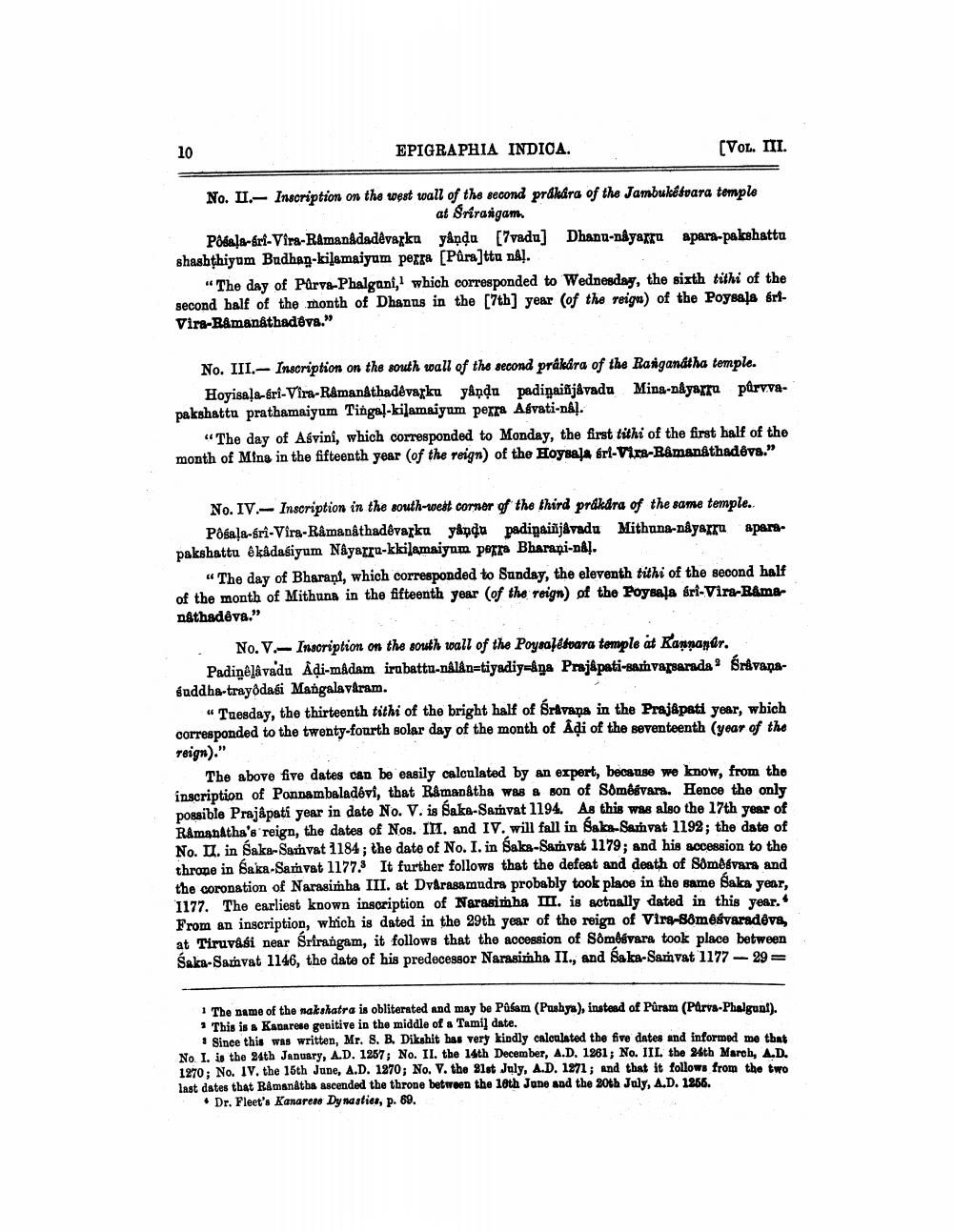________________
EPIGRAPHIA INDICA.
(VOL. III.
No. II.- Inscription on the west wall of the second pråkára of the Jambukếtvara temple
at Srirangam. Posa!a-Sri-Vira-Råmanddadêvacka påņda [7vadu] Dhand-näyarra apara-pakshattu shashthiyum Budhan-kilamaiyum perra (Para]ttu nal.
“The day of Parve-Phalgani, which corresponded to Wednesday, the sixth tithi of the second half of the month of Dhanus in the [7th) year (of the reign) of the Poysaļa krtVira-Ramanathadeva."
No. III.- Inscription on the south wall of the second pråkára of the Ranganatha temple.
Hoyisala-fri-Vira-Ramanathadevazku yându padiņaiñjávadu Mina-nyarra pärvvapakshattu prathamaiyum Tingal-kilamaiyum perra Agvati-na!.
"The day of Aśvini, which corresponded to Monday, the first tithi of the first half of the month of Mina in the fifteenth year (of the reign) of the Hoysala Srl-Vira-Ramanathadeva."
No.IV.- Inscription in the south-west corner of the third pråkdra of the same temple.
Pošaļa-fri-Vira-Ramanathadêvarku yanda padiņaiñjávadu Mithana-n&yacru aparapakshattu ekadasiyum Nayarru-kkilamaiyum perra Bharapi-nál.
“The day of Bharaņi, which corresponded to Sunday, the eleventh tithi of the second half of the month of Mithuna in the fifteenth year (of the reign) of the Poysala Sri-Vira-Ramanathadeva."
No.V.- Inscription on the south wall of the Poysalesvara temple at Kannapür. Padinêlávadu Adi-madam irubattu-nålân=tiyadiy=&ņa Prajapati-samvapsarada śråvanaguddha-trayodasi Mangalavaram.
Tuesday, the thirteenth tithi of the bright half of Sravans in the Prajapati year, wbich corresponded to the twenty-fourth solar day of the month of Ați of the seventeenth (year of the reign)."
The above five dates can be easily calculated by an expert, becanse we know, from the inscription of Pondambaladevi, that Ramanatha was a son of Somê vara. Hence the only possible Prajâpati year in date No. V. is Saka-Samvat 1194. As this was also the 17th year of Ramanatha's reign, the dates of Nos. III. and IV. will fall in Salo Samvat 1192: the date of No. II. in Saka-Samvat 1184 ; the date of No. I. in Saka-Samvat 1179; and his accession to the throne in Saka Samvat 1177. It further follows that the defeat and death of Som svara and the coronation of Narasimha III. at Dvarasamudra probably took place in the same Šaka year, 1177. The earliest known inscription of Narasimha II. is actually dated in this year. From an inscription, which is dated in the 29th year of the reign of Vira-Somośvaradova, at Tiruvasi near Srirangam, it follows that the accession of Som svara took place between Saka-Sauvat 1146, the date of his predecessor Narasimha II., and Saka-Samvat 1177 - 29 =
1 The name of the nakshatra is obliterated and may be Pasam (Pushya), instead of Püram (Parva-Phalgun!). * This is a Kadarese genitive in the middle of a Tamil date.
1 Since this was written, Mr. 8. B. Dikshit has very kindly calculated the five dates and informed me that No I. is the 24th January, A.D. 1267, No. II. the 14th December, A.D. 1261; No. IIL the 4th March, A.D. 1270: No. IV. the 15th June, A.D. 1270; No. V. the 21st July, A.D. 1271; and that it follows from the two last dates that Ramanatha ascended the throne between the 18th June and the 20th July, A.D. 1256.
• Dr. Fleet's Kanareae Dynasties, p. 69.




